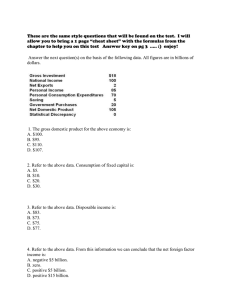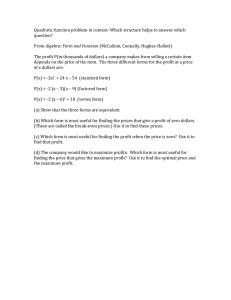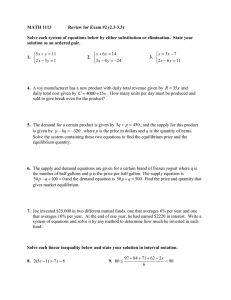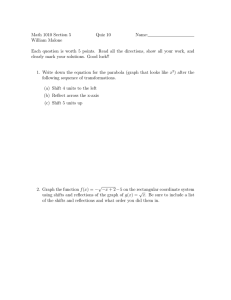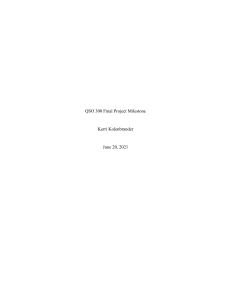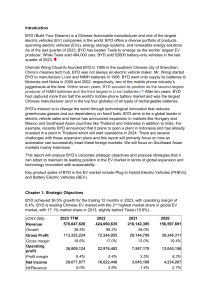means Y 45 Expenditure C+I+G+net X
advertisement
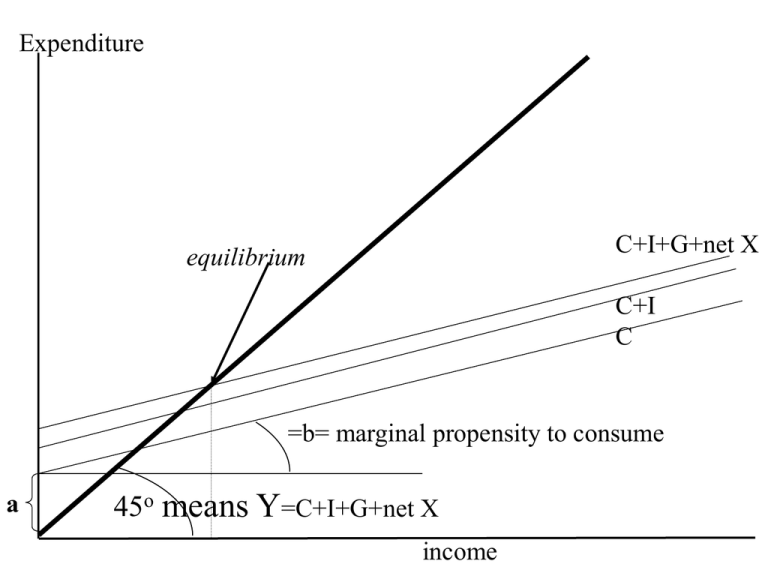
Expenditure
C+I+G+net X
equilibrium
C+I
C
=b= marginal propensity to consume
a
45o means Y=C+I+G+net X
income
Expenditure
New equilibrium
New
C+I+G+net X
$10 billion Old equilibrium
More
Govt
Expenditure
C+I+G+net X
45o
HOW MUCH DOES
INCOME RISE?
income
Expenditure
$10 b.
More
Expenditure
45o
$10 b.
Means $9 b.
More income
More income
Means $9
b. more Expend
Means $10 b.
More income
Etc.
Etc.
New
C+I+G+net X
C+I+G+net X
INCOME RISES BY
$100 BILLION.
income
New equilibrium
New
C+I+G+net X
$10 billion Old equilibrium
More
Govt
Expenditure
C+I+G+net X
45o means Y=C+I+G+net X
C+I
C
Shifts of the Consumption
Function
• In the function C = a + bYD a change in
either of the values of a or b will change
the dimensions of the function.
CONSUMPTION (C) (dollars per year)
Shifts of the Consumption
Function
C = a2 + bYD
C = a1 + bYD
a2
a1
0
DISPOSABLE INCOME(dollars per year)
CONSUMPTION (C) (dollars per year)
Shifts of the Consumption
Function
C = a2 + bYD
Increased confidence
==>increased consumption
of $100 billion
a2
a1
0
DISPOSABLE INCOME(dollars per year)
C = a1 + bYD
CONSUMPTION (C) (dollars per year)
Shifts of the Consumption
Function
Increased consumption
of $100 billion
==>Increased income
of $100 billion
a2
a1
0
DISPOSABLE INCOME(dollars per year)
C = a2 + bYD
C = a1 + bYD
CONSUMPTION (C) (dollars per year)
Shifts of the Consumption
Function
ASSUME MPC=.8
Increased income
of $100 billion
==>Increased consumption
of $80 billion
a2
a1
0
DISPOSABLE INCOME(dollars per year)
C = a2 + bYD
C = a1 + bYD
CONSUMPTION (C) (dollars per year)
Shifts of the Consumption
Function
Increased consumption
of $80 billion
==>Increased income
of $80 billion
a2
a1
0
DISPOSABLE INCOME(dollars per year)
C = a2 + bYD
C = a1 + bYD
CONSUMPTION (C) (dollars per year)
Shifts of the Consumption
Function
ASSUME MPC=.8
Increased income
of $80 billion
==>Increased consumption
of $64 billion
a2
a1
0
DISPOSABLE INCOME(dollars per year)
C = a2 + bYD
C = a1 + bYD
CONSUMPTION (C) (dollars per year)
Shifts of the Consumption
Function
Increased income
of $64 billion
==>Increased income
of $64 billion
a2
a1
0
DISPOSABLE INCOME(dollars per year)
C = a2 + bYD
C = a1 + bYD
CONSUMPTION (C) (dollars per year)
ULTIMATELY IS 5 TIMES
GREATER THAN INITIAL SHIFT
C = a2 + bYD
+51.2...
+80
100
+64
500
a2
a1
0
DISPOSABLE INCOME(dollars per year)
C = a1 + bYD
THE MULTIPLIER
___1___ =
___1___
100 * 1-MPC
100 * 1- 0.80
=500
CONSUMPTION
(billions of dollars per year)
Shifts vs. Movements
f
Cf
C = a1 + bYD
g
Cg
C = a2 + bYD
Shift
a1
h
Ch
a2
0
Y2
Y1
DISPOSABLE INCOME (billions of dollars per year)
NO FOREIGN SECTOR, NO GOVERNMENT
Structural Equations:
Z=C+I+G
Identity
Yd= C + S
Capital letters are endogenous
Y=Z
Equilibrium
C=co + c1 *Yd
Behavioral
I=Io
Exogenous
Reduced Form Equations:
Y = 1/(1-c1) * {co +Io}
S= Y-C
GOVERNMENT BUT NO FOREIGN SECTOR
Structural Equations:
Z=C+I+G
Identity
Yd= C + S
Y=Z
Equilibrium
C=co + c1 *Yd
Behavioral
=co + c1 *(Y-T)
I=Io
G=Go
Exogenous
T=To
Reduced Form Equations:
Y = 1/(1-c1) * {co - c1 *To +Io +Go}
S= Y-T-C
GOVERNMENT w/ INCOME TAX BUT NO FOREIGN SECTOR
Structural Equations:
Z=C+I+G
Identity
Yd= C + S
Y=Z
Equilibrium
C=co + c1 *Yd
Behavioral
=co + c1 *(Y-To- t*Y)
I=Io
Parameter
G=Go
Exogenous
T=To+ t*Y
Reduced Form Equations:
Y = 1/(1-c1 +t*c1) * {co +Io +Go-c1To}
S= Y-T-C
GOVERNMENT w/ INCOME TAX and FOREIGN SECTOR
Structural Equations:
Z=C+I+G+X-IM
Identity
Yd= C + S
Y=Z
Equilibrium
C=co + c1 *Yd
Behavioral
=co + c1 *(Y- t*Y)
I=Io
Parameter
G=Go
Exogenous
T=To+t*Y, IM=q*Y
Reduced Form Equations:
Y = 1/(1-c1 +t*c1+q) * {co +Io +Go+To}
S= Y-T-C
MACROECONOMIC SCHOOLS OF THOUGHT
Classical Economics:
1920s
Keynes’ General Theory: 1930s
Keynesian Cross: 1940s
IS-LM & Phillips Curve:
1950s
Monetarism: 1960s
New Classical Economics:1970s
New Keynesian Economics: 1980s
Post Keynesian Economics:
1950s-1990s
Lower Price
Lower
Output
Higher Price
Leftward
(downward)
Shift of Demand
Leftward
(upward)
Shift of
Supply
Higher
Output
Rightward
(downward)
Shift of
Supply
Rightward
(upward)
Shift of Demand
Breakdown all shifts into their output and price vectors
Lower Price (deflation) Higher Price (inflation)
Lower
Output
(slow
Growth)
RECESSION/DEPRESSION
Leftward
(downward)
Shift of Aggregate
Demand:
STAGFLATION
Leftward
(upward)
Shift of
Aggregate
Supply:
less injections,
or more leakages
Less factors or
higher factor prices
Higher
Output
(fast
Growth)
HIGH GROWTH
-LOW INFLATION
Rightward
(downward)
Shift of
Supply :
More factors or
lower factor prices
HIGH GROWTH
-HIGH INFLATION
Rightward
(upward)
Shift of Demand:
mor injections,
or less leakages
Breakdown all shifts into their output and price vectors
Lower Price
Lower
Output
Higher Price
Less productivity (technological change)
Higher price of resources
Seller expectations of future surpluses
Less number of sellers
Leftward
(downward)
Shift of Demand
less income
less tastes for good
less buyers
less complement
lower priuce for substitutes
Buyer expectations about future
shortages
Higher
Output
Rightward
(downward)
Shift of
Supply
Leftward
(upward)
Shift of
Supply
More productivity (technological change)
Lower price of resources
Seller expectations of future shortages
More number of sellers
Rightward
(upward)
Shift of Demand
Breakdown all shifts into their output and price vectors
More income
More tastes for good
More buyers
More complement
Higher priuce for substitutes
Buyer expectations about future
shortages
